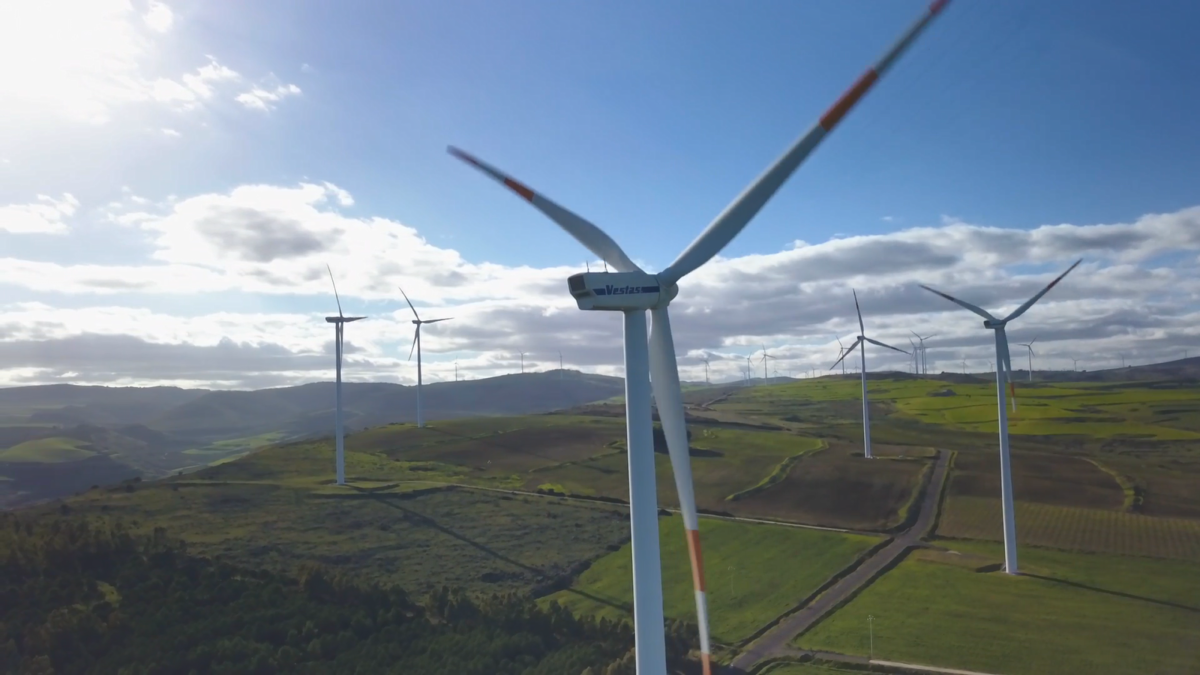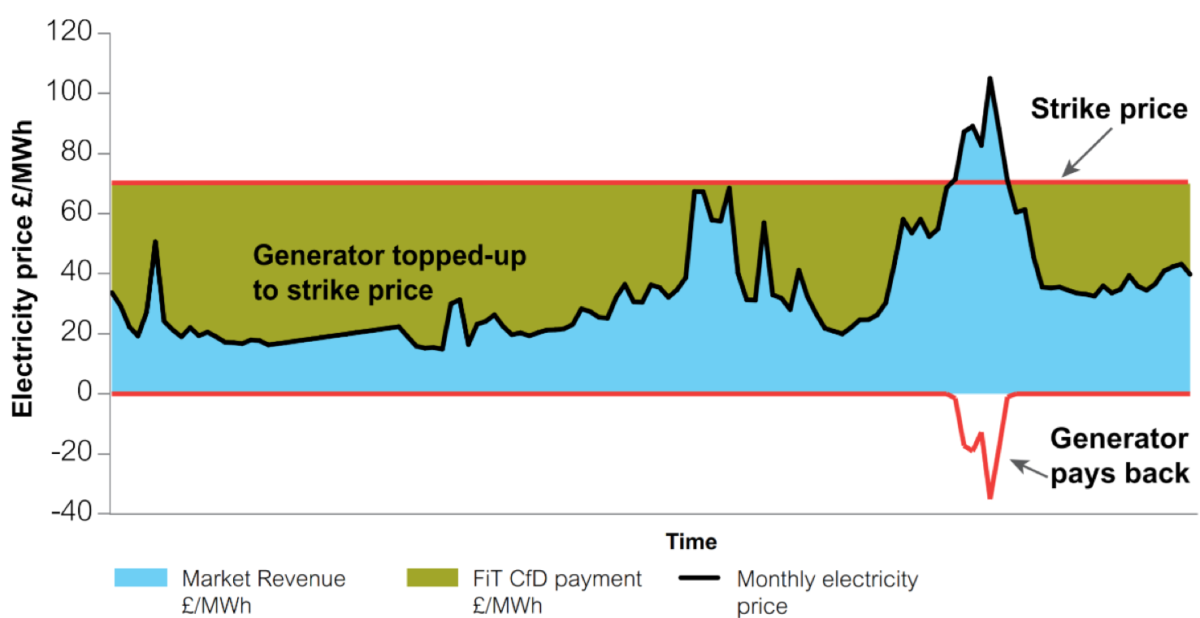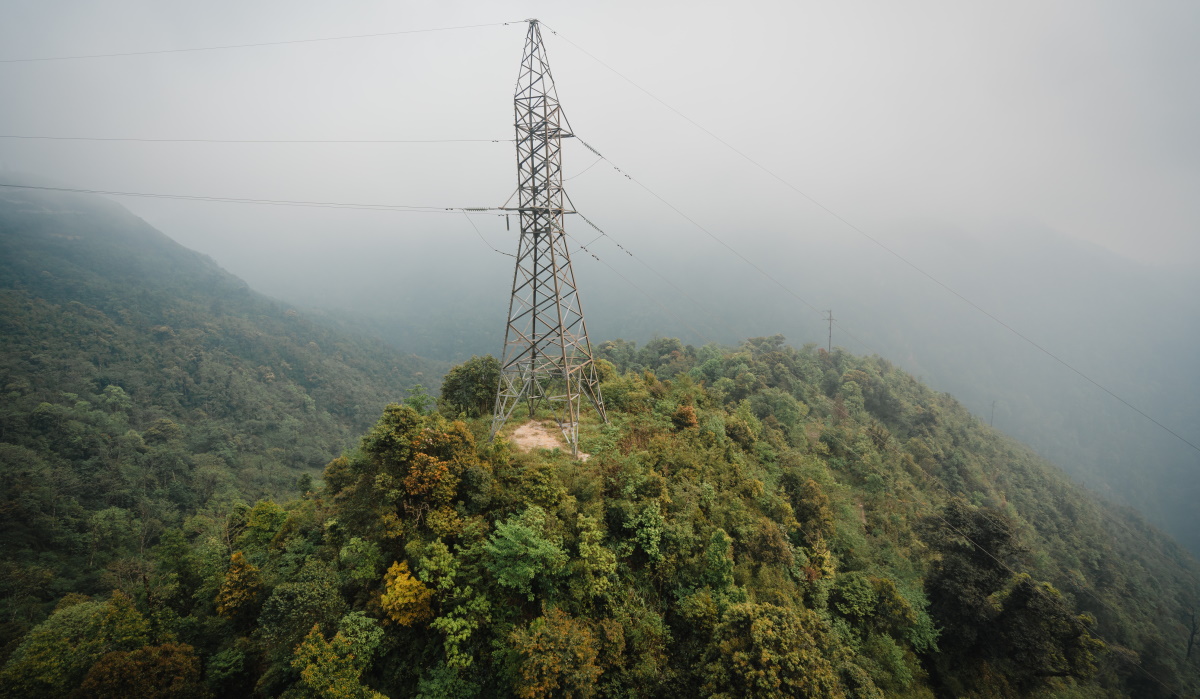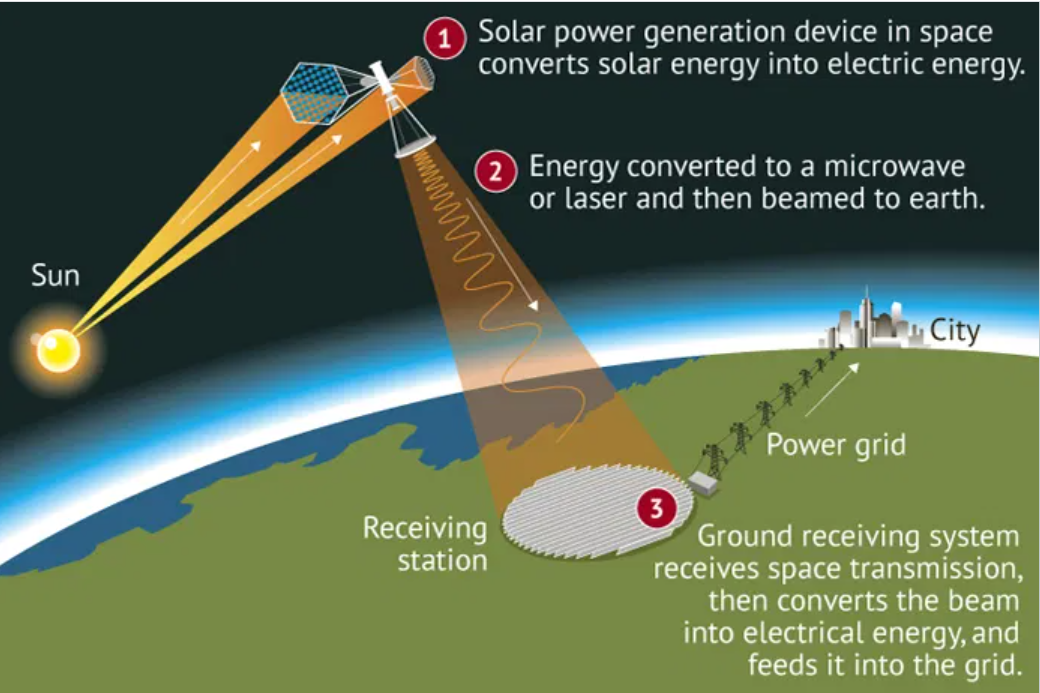March 2020: Onshore wind; electricity from air and fruit waste; decarbonisation of heat; energy storage; and innovating to net zero!
Onshore wind is back!
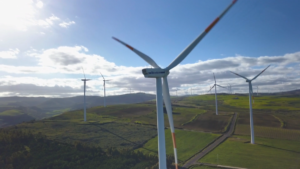 The UK government is minded to end its ideological ban on onshore wind energy, the cheapest form of energy, with an announcement that this technology will be allowed to participate in the in the next round of Contracts for Difference (CfD) auctions in 2021. Solar, floating offshore wind and energy storage are also eligible technologies. All of these technologies, but particularly onshore wind, are crucial tools in tackling climate change. Re-opening market access will be a massive positive step forward on our decarbonisation journey.
The UK government is minded to end its ideological ban on onshore wind energy, the cheapest form of energy, with an announcement that this technology will be allowed to participate in the in the next round of Contracts for Difference (CfD) auctions in 2021. Solar, floating offshore wind and energy storage are also eligible technologies. All of these technologies, but particularly onshore wind, are crucial tools in tackling climate change. Re-opening market access will be a massive positive step forward on our decarbonisation journey.
This change in Government position is accompanied with new guidance for renewable energy developers to ensure local communities have a say in developments, and receive community benefits.
According to the Government, one of the reasons to include onshore wind and solar is because, “there is a risk that if we were to rely on merchant deployment of these technologies alone at this point in time, we may not see the rate and scale of new projects needed in the near-term to support decarbonisation of the power sector and meet the Net Zero commitment at low cost.”
This change is a great example of long-term policy support which is so critically needed and therefore much applauded.
 The government made this announcement in its launch of a consultation on these proposed changes. The consultation ends on 22 May 2020 so please give your views and help ensure that all of these technologies can play a role in delivering Net Zero! You can also give your view on other aspects from how to ensure local communities benefit from renewable energy developments; exclusion of biomass; negative prices; to what storage solutions could be co-located with CfD projects.
The government made this announcement in its launch of a consultation on these proposed changes. The consultation ends on 22 May 2020 so please give your views and help ensure that all of these technologies can play a role in delivering Net Zero! You can also give your view on other aspects from how to ensure local communities benefit from renewable energy developments; exclusion of biomass; negative prices; to what storage solutions could be co-located with CfD projects.
What is the CfD?
The CfD scheme is the government’s main mechanism for supporting low-carbon electricity generation. A CfD is a long-term contract between the government and an electricity generator and guarantees a price for the electricity produced (the “strike price”) over ~15 years. This long-term contract gives investors the confidence to develop infrastructure which have high upfront costs and long lifetimes.
Energy generators can apply for a CfD by submitting a ‘sealed bid’ in a specified auction round every two years; contracts are awarded to the lowest prices.
There are different categories of technologies under the CfD: Pot 1 (established technologies, such as onshore wind and solar) and Pot 2 (less established technologies, such as offshore wind and biomass CHP). Only Pot 2 technologies have been eligible for the last two rounds. This change by Government allows technologies in Pot 1 to enter the auction. Hurrah!
How should energy professionals respond to the climate emergency?
 Many individuals, organisations, cities and nations around the world have declared a climate emergency. But how should energy professionals respond?
Many individuals, organisations, cities and nations around the world have declared a climate emergency. But how should energy professionals respond?
If you are interested in this question and would like to contribute your thoughts please book your place on a free event to be held on 3 April. It is planned that this will be a highly interactive and stimulating event, hosted at The Crystal in London.
This event is being organised by the Centre for Research into Energy Demand Solutions (CREDS): a consortium of over 120 people and 15 universities working on energy demand, efficiency and flexibility, in other words, how and why energy is used, rather than how it is produced. Using the outputs of the event, CREDS will produce a set of clear recommendations for researchers, policy makers, funders and publishers.
The event will be run along the line of a Citizen’s Assembly, and people involved in the energy transition, from academia, consultancies and the third sector are all invited to discuss different approaches and to learn from each other.
Book your place before bookings close on 23rd March 2020. Feel free to spread the news about this event!
Words, words, words
In a new regular feature, we will be shining a light on words used in energy circles – many of which have been coined since Shakespeare’s day.
This month: Prosumer. What or who is a Prosumer? Are you one?
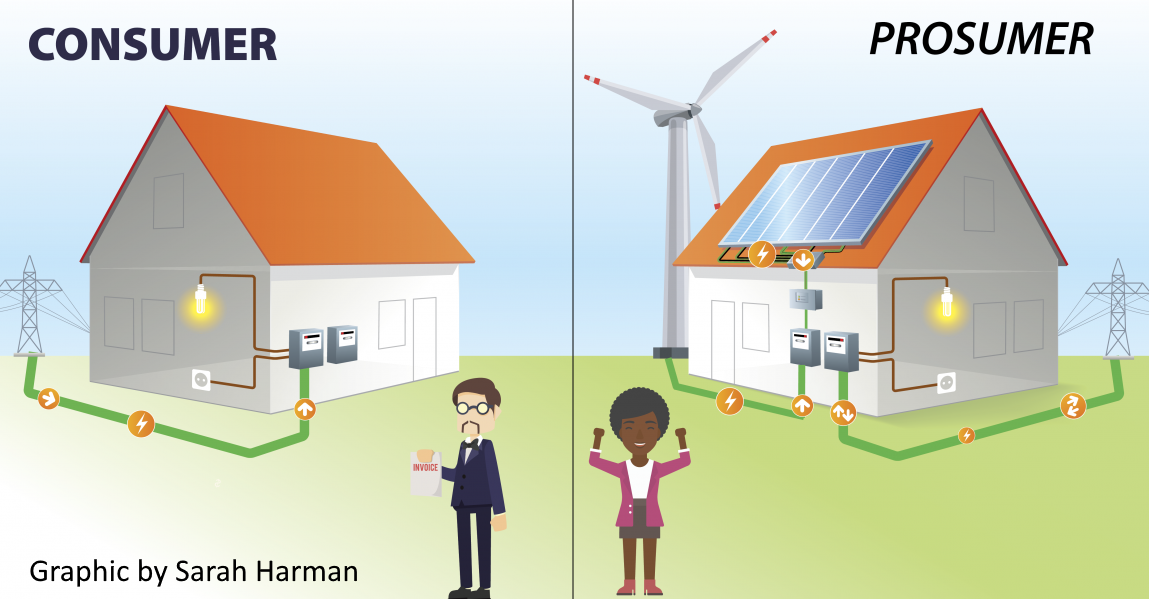 A prosumer is a person who both consumes and produces a product.
A prosumer is a person who both consumes and produces a product.
In the case of electricity, we all used to be consumers as the production of power was controlled by companies operating power plants and sent to our homes via the national grid. It was a one-way flow.
Now, people can produce and consume their own electricity by, for example, installing solar panels on the roof of their home. By generating their own power in this way they cease to be a consumer but become a prosumer. Electricity now flows in two directions: such households still receive electricity from the national grid as before, but also export any surplus electricity that they have generated but not consumed.
The creation of the prosumer has been enabled by technological developments, awareness of energy, and individuals wanting to generate renewable power for cost and environmental reasons.
Electricity from thin air and capacitors from stinky fruit!
“We are literally making electricity out of thin air…”
 Hold on – maybe we don’t need wind turbines and solar panels in the future… Scientists at the University of Massachusetts Amherst have developed a device that uses a natural protein to create electricity from humidity and moisture present in the air across the globe.
Hold on – maybe we don’t need wind turbines and solar panels in the future… Scientists at the University of Massachusetts Amherst have developed a device that uses a natural protein to create electricity from humidity and moisture present in the air across the globe.
Their “Air-gen” or air-powered generator comprises thin-film devices made from nanometre-scale protein wires harvested from the microbe Geobacter sulfurreducens, which can generate continuous electric power in the ambient environment. G. sulfurreducens is known as an “electricigen” due to its ability to create an electric current and produce electricity. The devices produce a sustained voltage that charged up capacitors, which then powered a LED display in the experiments.
The power is generated by a self-maintained moisture gradient that forms within the film when it is exposed to the humidity naturally present in air. The researchers, an electrical engineer and microbiologist, claim the device can generate power even in areas with extremely low humidity such as deserts, and does not require sunlight or wind, and can generate electricity indoors.
Currently the devices can power small electronics; the researchers hope to scale up to create possible electronic wearables and mobile phones thus eliminating batteries.
…and stinky fruit waste!
Scientists from the University of Sydney have used the waste from durian and jackfruit to create super capacitors that can store energy for rapid electricity charging.
By heating and then freeze-drying the fruit residue, the durian and jackfruit were transformed into stable aerogels, which are extremely light and porous synthetic materials. These aerogels were used to make electrodes, which have exceptional energy storage properties, much greater than existing super-capacitors made from activated carbon.
This method has created a useful product out of a waste material that is zero-cost and which needs to be got rid of quickly due to its repulsive smell. The durian has a smell like a blend of rotten onions, turpentine, and raw sewage, which lingers for days. Nice!
Further development and upscaling could lead the way to scale up the creation of naturally derived super-capacitors for high-efficiency energy storage devices – in airtight labs to prevent the smell escaping, of course…
Innovating to Net Zero
 The Energy Systems Catapult says that Net Zero by 2050 in the UK is possible if we make systemic change across society, making big changes to land use and lifestyles, and by rolling out low carbon technology at a large scale. Paradoxically, the Catapult also says that achieving Net Zero before this date is not possible, as this scale of change is unlikely to happen.
The Energy Systems Catapult says that Net Zero by 2050 in the UK is possible if we make systemic change across society, making big changes to land use and lifestyles, and by rolling out low carbon technology at a large scale. Paradoxically, the Catapult also says that achieving Net Zero before this date is not possible, as this scale of change is unlikely to happen.
Yet…
The huge, global changes currently being experienced because of the Coronavirus shows us that change certainly can be adopted by our global society, quickly and on a huge scale, if deemed necessary.
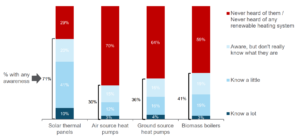 So why doubt that people are not ready to move quickly to reduce the risk of climate change? The most recent public survey by BEIS (“Wave 32”) shows that support for renewable energy remained incredibly high at 83%.
So why doubt that people are not ready to move quickly to reduce the risk of climate change? The most recent public survey by BEIS (“Wave 32”) shows that support for renewable energy remained incredibly high at 83%.
A key reason preventing change is lack of knowledge. In the same BEIS survey the vast majority of people had not even heard of, or knew very little about, renewable or low carbon heating options (such as heat pumps and district heating schemes).
There is clearly a massive need to roll out public information campaigns that reach everyone – individuals, households, and businesses – to raise awareness about energy use, where energy comes from, how we can be more energy efficient, and how we can switch to low carbon solutions. In the same survey, most people said that they trust the advice from tradespeople above other sources of information, so delivering industry focused information, and upskilling, is essential.

Another key reason is the cost: many people and organisations would like to adopt a low carbon approach but the current high cost of such technologies or lifestyles is a huge barrier.
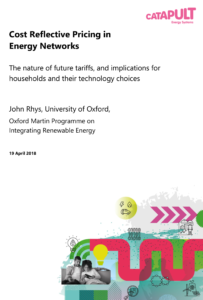 One way to address the cost, is to change the way energy is billed and how social and environmental tariffs are funded. Work by John Rhys of the Programme on Integrating Renewable Energy has shown that currently these tariffs (e.g. the winter fuel payment) are placed on electricity bills. Not only is this a regressive approach, hitting low users the most, but it also results in electricity being more expensive than gas; a real barrier to the switch from gas to electricity.
One way to address the cost, is to change the way energy is billed and how social and environmental tariffs are funded. Work by John Rhys of the Programme on Integrating Renewable Energy has shown that currently these tariffs (e.g. the winter fuel payment) are placed on electricity bills. Not only is this a regressive approach, hitting low users the most, but it also results in electricity being more expensive than gas; a real barrier to the switch from gas to electricity.
Given that 55% of people surveyed in the BEIS survey said cost concerns were the main reason why they were aware of how much heat they use, the reform of existing energy tariff pricing would help people to be able to switch from gas boilers to low carbon heat pumps.
Another way to change energy billing is by implementing the concept of ‘heat-as-a-service’ for heating homes, based on phone & broadband-style bundles. The idea involves customers paying for hours of warmth instead of a price per kWh which could help ease the transition to low-carbon forms of heat.
Trials have been ongoing in 100 homes across England and Wales, which are part of the Energy System Catapult’s Living Lab project. Smart heating systems were fitted in each home providing room by room temperature control for the occupant, and a wealth of behaviour data and building thermal performance.
Bristol Energy and Baxi Heating rolled out this trial, each adopting different approaches, but both focusing on deferring the up-front capital barrier associated with many low carbon heating options, and offer improved control and comfort, and ‘certainty of price’. The trial met with enthusiasm from participants. Other Living Lab trials involve testing the performance of hybrid heating systems and heat pumps.
We need to be realistic about what can and can’t be done, but large-scale change is possible if there is more willingness to support the roll out and adoption of some of the fantastic work currently being undertaken.
System Modelling
 The Catapult’s report is based on outputs from its national energy system-modelling environment, ESME, which uses a range of assumptions about people, technology, funding mechanisms and changes to land use.
The Catapult’s report is based on outputs from its national energy system-modelling environment, ESME, which uses a range of assumptions about people, technology, funding mechanisms and changes to land use.
ESME is a whole-system optimisation model and finds the least-cost combination of energy resources and technologies to meet UK energy demands. The outputs of ESME have informed the Committee on Climate Change, and the model has been used by industry, academia and the Government.
For the Net Zero analyses, the model was updated to include recent policy statements, and developments such as ships fuelled by hydrogen/ammonia; electrified off-road machinery; increased CCS capture rates; and direct air carbon capture and storage. It included more biomass and forestry; reductions in livestock farming and on demand for aviation. Many simulations were run of two scenarios that differ in terms of the degree of centralisation or top down coordination of large national strategic solutions such as nuclear, biomass and carbon capture and storage (CCS), and varying importance of renewables and societal change.
The modelling produced the following insights:
- Success depends on innovation across the whole system: in technology, land use change and behaviour.
- Net Zero cost can be limited to 1-2% of GDPwith stable, credible policies enacted by this Parliament to help reduce the cost of capital for the private sector.
- Net Zero before 2050is not possible without highly speculative changes to lifestyle, land use and low carbon technologies. Even if demand for aviation and livestock products were eliminated by 2050, and technology deployment raised to even more ambitious rates, Net Zero could only be brought forward to 2045.
- CCS and bioenergy are both essential to delivering Net Zero. Under Net Zero, CCS is also vital for mitigating industrial emissions and hydrogen production.
- Land use must be optimised to balance carbon sequestration with other priorities. New forests can provide a net carbon sink for decades during growth and bring wider environmental benefits. Biomass crops, when regularly harvested for energy (coupled with CCS), offer more intensive and indefinite sequestration.
- Hydrogen-based power may need to grow from virtually zeroto levels equivalent to today’s electricity generation to supply industry, heat and heavy transport.
- Electricity generation will need to doubleto supply huge increases in heating and transport (perhaps treble if also supporting hydrogen production).
- Offshore/onshore wind and solarwill need to grow significantly under any scenario.
- Advanced nuclear technologiesand small modular nuclear would be needed of the order of 7GW or around 20 300MW reactors to support three quarters of district heating in cities.
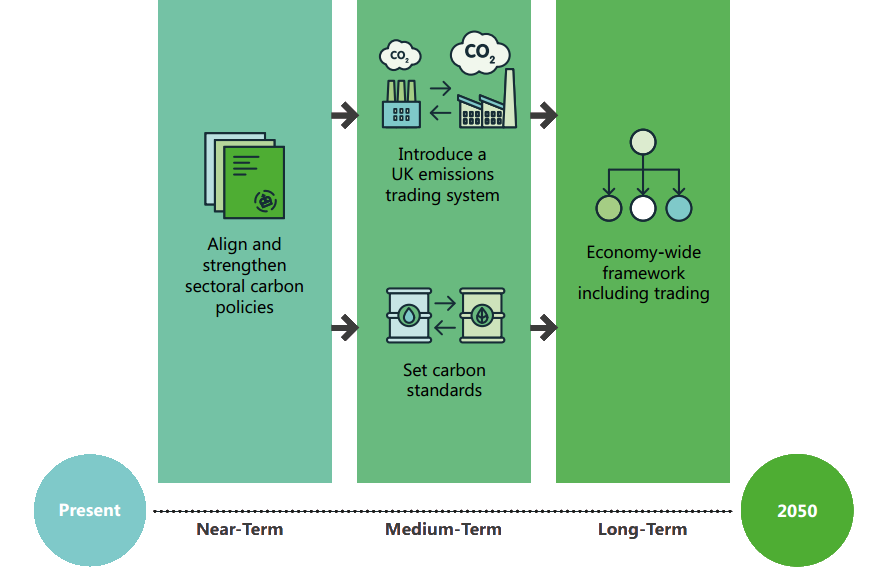 Policy and Regulatory reform
Policy and Regulatory reform
Robust and enduring policies and regulation are essential to give investors confidence to invest in low carbon products and services. Yet the UK’s current economic framework for decarbonisation is uneven and incomplete: there is a complex mix of policies (including taxes, subsidies, standards, and regulations) which create sub-optimal incentives to reduce greenhouse gas emissions.
Urgent alignment of policies must happen to ensure consistency across the economy, at the level required to meet carbon targets.
The Catapult state that the policy ecosystem will need to:
- Deliver credible long-term signals to incentivise innovation and private sector investment to develop and deploy a range of existing and new technologies;
- Shape markets so that private sector capital flows to deliver an efficient mix and phasing of emissions reduction across the economy; and
- Unlock investment in strategically important enabling infrastructures and technologies as well as shaping markets
Gravity based energy storage
Integrating renewable energy requires storage technologies. These can capture renewable energy when there is more being produced than demand for it, so that this cheap clean energy can be used later in time and/or space. Storage can come in many forms. Many take advantage of gravity.
 One very common form is pumped hydropower where water is pumped to a higher-level reservoir using excess electricity. Electricity is generated when needed, by releasing the water which then flows to a lower reservoir moving turbines on its way.
One very common form is pumped hydropower where water is pumped to a higher-level reservoir using excess electricity. Electricity is generated when needed, by releasing the water which then flows to a lower reservoir moving turbines on its way.
The start-up company Energy Vault have developed a twist on this.
Their idea is to use existing tall crane technology, controlled by automated software to construct and deconstruct a tower of blocks. The crane heads use electricity to lift 35-ton blocks from ground level to create a tower or stack. The stacked blocks hold kinetic energy, which is then quickly released when needed by lowering the block back to the ground, generating electricity. It is like pumped hydropower but with solids.
A 60 m working prototype has just been built in Switzerland. This is half the size of the standard tower, which according to Energy Vault, could store 35 MWh of electricity and provide 4 MW of continuous power discharge equivalent to power 2-3,000 households for eight hours.
Another gravity-based system is the use of weights in mine shafts.
Thomas Morstyn , of the Programme of Integrating Renewable Energy has published research on gravity storage using mine shafts in the former coal-mining region of the Midlands. The research found there are potentially 340 mine shafts that could be converted into gravity storage units with energy capacities above 1 MWh, providing 0.804 GWh of energy storage.
, of the Programme of Integrating Renewable Energy has published research on gravity storage using mine shafts in the former coal-mining region of the Midlands. The research found there are potentially 340 mine shafts that could be converted into gravity storage units with energy capacities above 1 MWh, providing 0.804 GWh of energy storage.
 This idea is being developed by the Edinburgh based company Gravitricity, which has the idea of installing electric winches in abandoned mine shafts. These winches would wind up weights using surplus electricity. The winches would then drop the weights (in a controlled way) when power is needed, providing bursts of power over a 15-minute to eight-hour period. The company claim its system could respond in seconds and act as a fast frequency back–up when the National Grid needs support, helping to prevent power cuts such as that which happened on 9 August 2019.
This idea is being developed by the Edinburgh based company Gravitricity, which has the idea of installing electric winches in abandoned mine shafts. These winches would wind up weights using surplus electricity. The winches would then drop the weights (in a controlled way) when power is needed, providing bursts of power over a 15-minute to eight-hour period. The company claim its system could respond in seconds and act as a fast frequency back–up when the National Grid needs support, helping to prevent power cuts such as that which happened on 9 August 2019.
Gravitricity are currently building a demonstrator model, and plan to soon install a prototype into a disused mine shaft in northern England. They say their idea could work in shafts up to 150m deep with weights up to 3000 tonnes.
Compared with other gravity energy storage technologies such as pumped hydropower, the use of suspended weights requires minimal land-use and can make use of existing excavations and technology. They have advantages over chemical batteries, as they are much more durable, and can charge and discharge many times. In addition, the weight of the drop could be adjusted to provide lower power levels over a longer period, or more power over a short timeframe. For mines, there is also the potential to combine the approach with compressed air energy storage, by sealing the underground shaft and adding a compressor and heat exchange.
The Decarbonisation of heat
 Regen hosted a webinar to launch its report “Decade to Make a Difference: Decarbonisation of Heat”
Regen hosted a webinar to launch its report “Decade to Make a Difference: Decarbonisation of Heat”
The report examines how to tackle carbon emissions from buildings in consumer-friendly ways. It explore the electrification of heat, the case for repurposing the existing gas grid and deploy hydrogen and biomethane, and the need for a mixed approach.
Decarbonising heat is the greatest barrier to achieving Net Zero goals because the delivery of low carbon heat must overcome funding, consumer, technological, infrastructure and market barriers. It is a huge challenge given that ~75% of heat in domestic and non-domestic buildings in Great Britain is created from burning natural gas (generating about 37% of the UK’s emissions) and that easy access to affordable heat has a profound impact in terms of comfort, well-being and productivity.
The UK sits near the bottom of the European league table for heat decarbonisation and also has amongst the worst buildings. Our buildings are not energy efficient and this leads to unnecessarily high bills and wasted emissions.
Taking measures towards low carbon heating and improving the quality of building fabrics also provide a great way to help those in fuel poverty. An average of 10% – 13% of households are classed as being in fuel poverty (nearly 25% in Scotland); fuel poverty has been identified as a contributor to unnecessary excess deaths: estimated to be 16,500 in the winter of 2017/2018 alone. This is so many more than has been currently experienced by the Coronavirus, so where is the urgent action to combat this? £12 billion in the 2020 Budget to offset the impact of Coronavirus in the UK: what about this killer?
 In line with Integrate’s call to reform existing energy tariff pricing to help people switch from gas, Regen also suggest that current social and environmental levies (which comprise about 21% of electricity bills) should be wrapped into a new fuel carbon levy. It also calls for a value to be placed on well-insulated, efficient, low carbon, buildings through the housing market and rental sectors, to recognise the benefits of such buildings to occupiers.
In line with Integrate’s call to reform existing energy tariff pricing to help people switch from gas, Regen also suggest that current social and environmental levies (which comprise about 21% of electricity bills) should be wrapped into a new fuel carbon levy. It also calls for a value to be placed on well-insulated, efficient, low carbon, buildings through the housing market and rental sectors, to recognise the benefits of such buildings to occupiers.
The paper’s key recommendations for national government and regional bodies include:
- Act to prioritise consumer protection, and measures to eradicate fuel poverty, in order to sustain social and political support for change.
- Create a consumer-led market for low carbon heat technologies and services. Address the current fuel price distortions and replace with a universal carbon levy to incentivise decarbonisation, fuel switching and new business models, alongside other market measures to reward carbon reduction and increase the sale and rental value of low carbon buildings.
- Adopt zero carbon building standards and embarking on a deeper and wider programme of efficiency and building fabric improvement, enabling regions, cities, owner-occupiers and businesses to improve building fabric and implement local heat strategies, which will be needed whatever the future heat decarbonisation pathway.
- Build consumer trust and stimulate market demand, by supporting the deployment of technologies and services that offer better, low carbon heating solutions. Engage with consumers while continuing to support solutions and exemplar projects that can demonstrate consumer value.
- Invest in both technology innovation and new infrastructure that will provide the basis for a heat revolution in the coming decades. Prioritising heat technology within the UK’s industrial strategy and enabling strategic infrastructure investment.
- Establish local partnerships, and governance structures, between communities, the public sector and the private sector to plan for and lead the heat transformation.
- Expand and sustain the low carbon supply chain, including the mass mobilisation and reskilling of heating engineers and service professionals.
The Government position on low carbon heating
In Regen’s webinar Liz Kitchen, policy lead for heat strategy at BEIS commented that her team is aiming to bring out its position on low carbon heating well after the Parliament’s summer break… so don’t hold your breath.
She said that more forthcoming would be an announcement on the Renewable Heat Incentive (RHI), scheduled to end in March 2021. And so it was. The 2020 Budget extended the RHI for another year, so it now ends in March 2022.
 The RHI was launched in late 2011, and expected to stimulate ‘nearly two million installations of renewable heat
The RHI was launched in late 2011, and expected to stimulate ‘nearly two million installations of renewable heat
technology’ resulting in circa 73 TWh of additional renewable heat generated per year by 2020. It has not done this: only 97,000 installations have been accredited under the scheme, with many metrics showing only some or little/no evidence in the development of a more sustainable renewable heat market. Yet with heat pumps being put forward as a major way to move to low carbon heating, support is still needed, and arguably much more than has been offered to date.
As a possible successor, the 2020 Budget mentioned a possible new low carbon heat support scheme from April 2022 to help roll out heat pumps and biomass boilers. More definite however was £270 million in a new Green Heat Networks Scheme, and £800 million to establish carbon capture and storage (CCS) in at least two UK sites by 2030.
Thanks for reading!
Why not subscribe to the Programme’s monthly newsletters to read about the latest research and industry news: http://bit.ly/3bWmdJJ
You may also be interested in the monthly newsletter from the Programme on the Future of Cooling: http://bit.ly/3bQblwP

